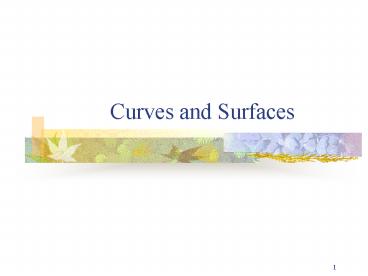Curves and Surfaces - PowerPoint PPT Presentation
1 / 47
Title:
Curves and Surfaces
Description:
Given the endpoints P1 and P4 and tangent vectors at R1 and R4. What ... Two endpoints, two direction points. Length of lines from each endpoint to its direction ... – PowerPoint PPT presentation
Number of Views:60
Avg rating:3.0/5.0
Title: Curves and Surfaces
1
Curves and Surfaces
2
Representation of Curves Surfaces
- Polygon Meshes
- Parametric Cubic Curves
- Parametric Bi-Cubic Surfaces
- Quadric Surfaces
- Specialized Modeling Techniques
3
The Teapot
4
Representing Polygon Meshes
- explicit representation
- by a list of vertex coordinates
- pointers to a vertex list
- pointers to an edge list
5
Pointers to a Vertex List
6
Pointers to an Edge List
7
Plane Equation
- AxByCzD0
- And (A, B, C) means the normal vector
- so, given points P1, P2, and P3 on the plane
- (A, B, C) P1P2 ? P1P3
- What happened if (A, B, C) (0, 0, 0)?
- The distance from a vertex (x, y, z) to the plane
is
8
Parametric Cubic Curves
- The cubic polynomials that define a curve segment
are of the form
9
Parametric Cubic Curves
- The curve segment can be rewrite as
- where
10
Continuity between curve segments
11
Tangent Vector
12
Continuity between curve segments
- G0 geometric continuity
- two curve segments join together
- G1 geometric continuity
- the directions (but not necessarily the
magnitudes) of the two segments tangent vectors
are equal at a join point
13
Continuity between curve segments
- C1 continuous
- the tangent vectors of the two cubic curve
segments are equal (both directions and
magnitudes) at the segments join point - Cn continuous
- the direction and magnitude of through the nth
derivative are equal at the join point
14
Continuity between curve segments
15
Continuity between curve segments
16
Three Types of Parametric Cubic Curves
- Hermite Curves
- defined by two endpoints and two endpoint tangent
vectors - Bézier Curves
- defined by two endpoints and two control points
which control the endpoint tangent vectors - Splines
- defined by four control points
17
Parametric Cubic Curves
- Rewrite the coefficient matrix as
- where M is a 4?4 basis matrix, G iscalled the
geometry matrix - so
18
Parametric Cubic Curves
- where is called the blending
function
19
Hermite Curves
- Given the endpoints P1 and P4 and tangent vectors
at R1 and R4 - What are
- Hermite basis matrix MH
- Hermite geometry vector GH
- Hermite blending functions BH
- By definition
20
Hermite Curves
- Since
21
Hermite Curves
- so
- and
22
Bezier Curves
- Four control points
- Two endpoints, two direction points
- Length of lines from each endpoint to its
direction point representing the speed with which
the curve sets off towards the direction point - Fig. 4.8, 4.9
23
Bézier Curves
- Given the endpoints and and two control points
and which determine the endpoints tangent
vectors, such that - What is
- Bézier basis matrix MB
- Bézier geometry vector GB
- Bézier blending functions BB
24
Bézier Curves
- by definition
- then
- so
25
Bézier Curves
- and
26
Subdividing Bézier Curves
- How to draw the curve ?
- How to convert it to be line-segments ?
27
Bezier Curves
- Constructing a Bezier curve
- Fig. 4.10-13
- Finding mid-points of lines
28
Bezier Curves
29
Convex Hull
30
Spline
- the polynomial coefficients for natural cubic
splines are dependent on all n control points - has one more degree of continuity than is
inherent in the Hermite and Bézier forms - moving any one control point affects the entire
curve - the computation time needed to invert the matrix
can interfere with rapid interactive reshaping of
a curve
31
B-Spline
32
Uniform NonRational B-Splines
- cubic B-Spline
- has m1 control points
- has m-2 cubic polynomial curve segments
- uniform
- the knots are spaced at equal intervals of the
parameter t - non-rational
- not rational cubic polynomial curves
33
Uniform NonRational B-Splines
- Curve segment Qi is defined by points
thus - B-Spline geometry matrix
- if
- then
34
Uniform NonRational B-Splines
- so B-Spline basis matrix
- B-Spline blending functions
35
NonUniform NonRational B-Splines
- the knot-value sequence is a nondecreasing
sequence - allow multiple knot and the number of identical
parameter is the multiplicity - Ex. (0,0,0,0,1,1,2,3,4,4,5,5,5,5)
- so
36
NonUniform NonRationalB-Splines
- Where is the jth-order blendingfunction
for weighting control point pi
37
Knot Multiplicity Continuity
- Since Q(ti) is within the convex hull of Pi-3,
Pi-2, and Pi-1 - If titi1, Q(ti) is within the convex hull of
Pi-3, Pi-2, and Pi-1 and the convex hull of
Pi-2, Pi-1, and Pi, so it will lie on Pi-2Pi-1 - If titi1ti2, Q(ti) will lie on pi-1
- If titi1ti2ti3, Q(ti) will lie on both Pi-1
and Pi, and the curve becomes broken
38
Knot Multiplicity Continuity
- multiplicity 1 C2 continuity
- multiplicity 2 C1 continuity
- multiplicity 3 C0 continuity
- multiplicity 4 no continuity
39
NURBSNonUniform Rational B-Splines
- rational
- x(t), y(t) and z(t) are defined as the ratio of
two cubic polynomials - rational cubic polynomial curve segments are
ratios of polynomials - can be Bézier, Hermite, or B-Splines
40
Parametric Bi-Cubic Surfaces
- Parametric cubic curves are
- so parametric bi-cubic surfaces are
- If we allow the points in G to vary in 3D along
some path, then - since Gi(t) are cubics
41
Parametric Bi-Cubic Surfaces
- so
42
Hermite Surfaces
43
Bézier Surfaces
44
B-Spline Surfaces
45
Normals to Surfaces
46
Quadric Surfaces
- implicit surface equation
- an alternative representation
47
Quadric Surfaces
- advantages
- computing the surface normal
- testing whether a point is on the surface
- computing z given x and y
- calculating intersections of one surface with
another

